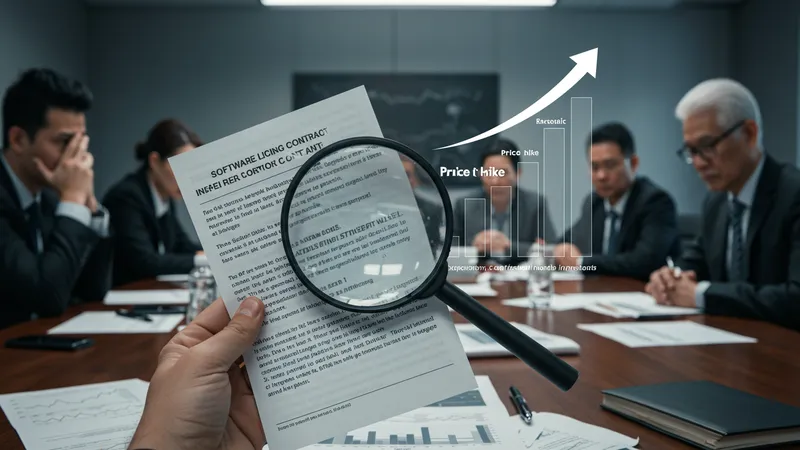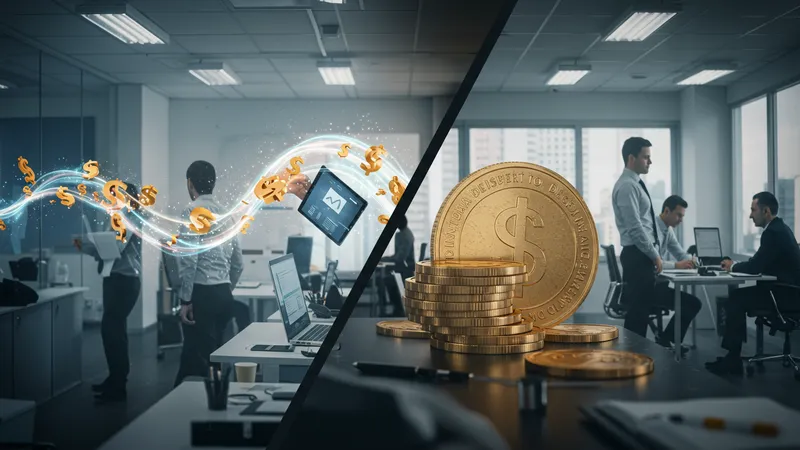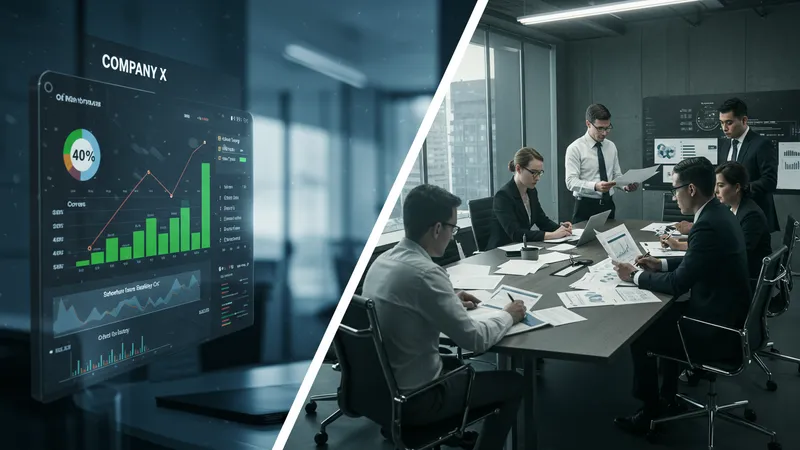What if I told you that thousands of companies are overpaying millions due to little-known traps in enterprise software licensing? It sounds surreal, yet it's happening right under your nose.
With businesses pivoting towards digital solutions, understanding the quirks of software licensing is more crucial than ever. Miss a clause, and the financial hit could be catastrophic.

Did you know that certain software licenses can change terms overnight? This means what you agreed to yesterday could morph into a financial trap today. Many companies are caught off guard, facing unexpected costs. But that’s not even the wildest part…
The labyrinth of software licensing hides pitfalls designed to lock you into long-term contracts. For instance, if you missed the renewal deadline by just a day, you might find yourself bound for another year — or paying hefty fees to opt out. And that’s just scratching the surface of what’s lurking behind these contracts…
Prepare yourself because what happens next shocked even the experts. Hidden claws, ambiguous clauses, and more — ready to unravel the tangled web of enterprise software licensing? Buckle up!
In the world of enterprise software licensing, the devil truly is in the details. These contracts often contain hidden clauses that can inflate costs unexpectedly. One of the most notorious clauses is the automatic renewal clause, which can leave companies paying for unused software if they don’t cancel in time. Even a single oversight can multiply costs dramatically.

Compounding the complexity, licensing terms can change without an obvious warning, turning an affordable option into an extraordinary expense. This flexibility often benefits software sellers, putting users at a relentless disadvantage. A surprise price hike is more common than you think, but there’s one more twist that often leaves companies baffled…
Some agreements include "limitation of liability" clauses that protect the vendor but leave the buyer financially vulnerable. This means that if the software fails or causes issues, the vendor isn't responsible for the repercussions—a painful realization in moments of crisis.
What you read next might change how you see this forever. There's an insider trick that savvy companies use to navigate these treacherous waters without a hitch. Eager to discover it?
License audits can come unexpectedly, turning into financial nightmares if not properly prepared. Vendors conduct audits to ensure compliance, but these often reveal non-compliance due to unforeseen usage or minor errors. The costs of remediation can be steep, often involving retroactive fees and penalties.

To outsmart the audits, companies are now employing strategic license management tools. These digital allies track software usage meticulously, ensuring that not a single byte goes unaccounted for. While they require initial investment, the long-term savings and peace of mind are invaluable.
Another savvy strategy is to conduct internal audits regularly. By doing so, companies can preempt external audits, allowing time to rectify discrepancies without the pressure or financial implications of an official audit. But even this isn’t foolproof...
A recent survey revealed that despite best efforts, many companies still fall into the audit trap due to unintentional breaches of agreement nuances. But the truly shocking revelation is what firms are now doing to finally gain the upper hand...
Choosing between subscription and perpetual licensing isn’t merely a matter of cost; it’s a strategic decision that influences a company's financial future and operational flexibility. Subscription licenses offer lower upfront costs but demand continuous payments. On the other hand, perpetual licenses require a significant initial investment but potentially provide long-term savings.

Countless businesses have switched to subscription models for their flexibility, particularly in rapidly changing industries where scalability is key. Conversely, industries with static software needs often find perpetual licensing more advantageous, yet there is a twist that many miss...
The hidden cost of subscription models is the regular renewal negotiations, which can lead to price increases that far exceed inflation rates. Perpetual licenses, meanwhile, might seem deceptively cost-effective but often miss out on the benefits of automatic software updates and support.
What's truly mind-boggling is the trend that is starting to emerge. A hybrid model that combines the best of both worlds is gaining traction, offering the flexibility of subscriptions with the stability of perpetual agreements. Curious to know how this could reshape licensing as we know it?
Open-source software is becoming a game-changer in the realm of enterprise licensing, offering firms a cost-effective alternative without compromising on quality. Once considered a risky choice, it's now viable due to robust community support and increased corporate adoption.

The economic appeal is undeniable: Many open-source platforms are free to use, allowing companies to drastically cut costs. However, maintaining and customizing such software can still involve hidden costs, especially if lacking in-house expertise. The compelling aspect is how companies are balancing these factors…
One big advantage open-source software boasts is its flexibility. Companies are not hostage to strict licensing agreements, giving them the freedom to tailor solutions to their unique needs. The open-source community continuously improves features, patch vulnerabilities, and enhance performance, offering a dynamic solution to static alternatives.
But here's the incredulous part: Some companies are now developing entirely bespoke systems from open-source foundations to escape traditional licensing altogether. Could this spell the end for conventional software giants? We'll dive deeper into this potential tech revolution next…
High-stakes negotiations with software vendors can determine whether your enterprise soars or sinks under license costs. The art of negotiation is more crucial than ever, with cunning tactics and timing often resulting in substantial savings.

Understanding a vendor’s fiscal year can be a powerful advantage. Vendors under pressure to achieve quarterly or annual targets might offer better licensing terms or discounts toward the end of these periods.
Buyers are also discovering the strength of a unified voice. When companies band together or leverage collective bargaining, they command greater influence. An increasing number of firms are teaming up to form coalitions, leveraging collective buying power to negotiate favorable terms.
But there’s a negotiation tactic so clever, it leaves the vendors exasperated yet compliant. Imagine securing contracts that allow fluctuating software needs to adapt seamlessly, without penalties. Are you curious about how these businesses transformed negotiations into a precision sport?
In the maze of licensing agreements, consultants can appear as unnecessary expenses, but their impact can be monumental. These experts know the ins and outs of contracts, oftentimes saving companies significantly more than their fees.

Licensing consultants dissect every line of a contract, uncovering hidden consequences that in-house teams might overlook. Their awareness of industry standards and vendor tactics puts businesses at a distinct advantage.
Rather than a one-time investment, many firms now see these experts as integral to their continuous strategy, regularly auditing and optimizing licensing arrangements. Consultants can negotiate from a position of knowledge that aligns vendors' expectations with the realistic needs of the company.
The most surprising part is how consultancies are redefining their role, forming long-term partnerships that influence innovation within client companies. Could this nurturing of relationships revolutionize the way businesses manage licenses? We explore this disruptive trend next…
While software licenses are often criticized for their restrictive nature, astute companies are exploiting clauses that serve their advantage. These hidden gems in contract verbiage might offer unexpected flexibility.

Such opportunities include "most-favored customer" clauses, ensuring that companies receive the best available pricing similar to top-tier clients. These clauses can be leveraged during negotiations to secure favorable terms.
Archiving provisions, often overlooked, can also offer value. They might allow businesses to retain software for backup purposes without additional charges, an invaluable aspect when preparing for audits or transitioning between software systems.
Exploring these overlooked details can prove transformational. Imagine unlocking the agility to renegotiate when unforeseen circumstances change software needs or discovering a clause that offers more freedom than initially perceived. Ready to delve into these crafty contractual strategies?
Success stories in software licensing can provide invaluable lessons. Take Company X, which, through astute management and an envelope-pushing approach, slashed licensing costs by 40% while increasing software agility.

Then there’s Company Y, which turned a potential disaster into triumph by employing innovative internal audit protocols. The result was their ability to preempt external audits, saving significant costs and avoiding potential penalties altogether.
Meanwhile, Company Z harnessed the power of collective bargaining. By aligning its strategic interests with industry peers, it negotiated exceptionally favorable terms that would have been impossible as a sole buyer.
These transformative stories highlight the importance of foresight and strategic agility. Could a similar reinvention be lying in wait for your company’s software licensing? The potential for significant change rests on the horizon, ready for those daring enough to seize it.
Transitioning to cloud-based licensing promises unprecedented flexibility, but with it comes a suite of challenges. Enterprises face the conundrum of navigating complexities while ensuring scalability and data security are uncompromised.

On the one hand, the cloud offers unparalleled agility, enabling companies to scale resources on demand. This adaptability is a double-edged sword, however, as improper scaling or oversight can inadvertently bloat costs.
Moreover, the ongoing shift to cloud solutions complicates how licenses are managed. Organizations must maintain accurate inventory and usage monitoring to avoid compliance issues or unexpected costs, a difficult yet crucial undertaking.
The evolution of cloud licensing has clients carefully examining each service level agreement. What’s astonishing is how some enterprises are pioneering innovative approaches to leverage cloud benefits while minimizing potential drawbacks. Here’s how they’re mastering the cloud with strategic foresight...
Artificial intelligence is swiftly becoming a crucial asset in simplifying and optimizing software licensing. With AI-driven analysis, companies can swiftly identify usage patterns, compliance risks, and cost-saving opportunities.

AI-assisted auditing enables enterprises to detect irregularities that human oversight might miss, thus bolstering compliance and financial efficiency. This transformative application of AI reduces both time spent on audits and the potential for costly human error.
The most game-changing aspect is predictive analytics. By forecasting trends and consumption, AI enables companies to make educated decisions about future software needs, aligning resources and budgets to actual requirements.
What’s even more promising is the envisioning of AI-managed negotiations, where algorithms tailor the best licensing terms by analyzing historical data and vendor behavior. How could this predictive precision reshape the entire licensing landscape? There’s much more to come…
Looking ahead, the world of enterprise software licensing is poised for a seismic shift. New technologies, evolving business environments, and user demands will shape tomorrow’s licensing strategies.

Among the top trends is a shift towards more personalized licensing agreements, with AI playing an instrumental role. These data-informed agreements promise to meet specific business needs more efficiently, marking a departure from one-size-fits-all solutions.
The move toward decentralization is another burgeoning trend. As blockchain technology advances, its influence on licensing will likely grow, encouraging more transparent and secure agreements.
Companies need to remain agile, ready to pivot as these trends solidify and others emerge. An era of dynamic licensing awaits, offering incredible potential for those ready to embrace innovation over traditional methods. What bold new pathways are yet to be explored? The future is bright, and the journey continues…
Enterprise software licensing doesn't have to be a daunting maze of confusion and hidden costs. By embracing adaptive strategies and innovation, companies can master the necessary art of negotiation and compliance. Strategic foresight and the courage to embrace new technologies stand as your best allies.

The first step is shifting the mindset from reactive problem-solving to proactive planning and optimization. Strategies outlined here are already trailblazing paths for pioneering businesses — the real question is, are you ready to join them?
Whether exploring AI, open-source options, or novel negotiation methods, stand on the precipice of transformative change. The power to redefine the software licensing landscape is within reach, inviting bold action to turn surprise and disruption into competitive advantage.
Take what you’ve learned and project your strategies towards the future—consider it a call to action. Share this journey with your network, bookmark these insights, and prepare to revolutionize how your enterprise handles its software licensing. The future of efficient licensing is yours to create.